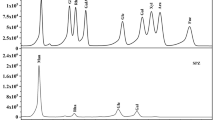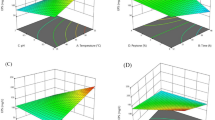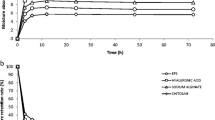Abstract
Two odorless, water-soluble exopolysaccharide (EPS) fractions, EPS-1 and EPS-2, were isolated from a newly isolated Bacillus amyloliquefaciens strain C-1 and purified by ion exchange and gel chromatography. The purified EPS-1 contained glucose/mannose/galactose/arabinose in a relative proportion of 15:4:2:1, and possessed a molecular weight of 79.6 kDa, while EPS-2 contained only glucose and mannose in a 3:1 ratio, with the molecular weights of 19.8 kDa. The antioxidant activity results showed that EPS-1 exhibited strong reducing power, superoxide radicals (O2−·), and hydroxyl free radicals (OH·) scavenging activities. For the H2O2-induced injury in HepG2 cells, EPS-1 significantly decreased the formation of reactive oxygen species, intracellular malondialdehyde levels, and restored intracellular superoxide dismutase activity. For EPS-2, there had no detectable antioxidant activities. And all these results collectively showed that as a natural antioxidant, only EPS-1 produced by C-1 had considerable potential to be used as medical compounds or functional additives.






Similar content being viewed by others
References
Aharoni-Simon Reifen R, Tirosh O (2006) ROS-production-mediated activation of AP-1 but not NFkappaB inhibits glutamate-induced HT4 neuronal cell death. Antioxid Redox Sig 8:1339–1349
Ananthi S, Raghavendran HRB, Sunil AG et al (2010) In vitro antioxidant and in vivo anti-inflammatory potential of crude polysaccharide from Turbinaria ornata (Marine Brown Alga). Food Chem Toxicol 48:187–192
Athukorala Y, Kim KN, Jeon YJ (2006) Antiproliferative and antioxidant properties of an enzymatic hydrolysate from brown alga, Ecklonia cava. Food Chem Toxicol 44:1065–1074
Bramhachari PV, Dubey SK (2006) Isolation and characterization of exopolysaccharide produced by Vibrio harveyi strain VB23. Lett Appl Microbiol 43:571–577
Capek P, Machova E, Turjan J (2009) Scavenging and antioxidant activities of immunomodulating polysaccharides isolated from Salvia officinalis L. Int J Food Microbiol 44:75–80
Chen H, Wang Z, Qu Z et al (2009) Physicochemical characterization and antioxidant activity of a polysaccharide isolated from oolong tea. Eur Food Res Technol 229:629–635
Chen H, Yan X, Zhu P et al (2006) Antioxidant activity and hepatoprotective potential of agaro-oligosaccharides in vitro and in vivo. Nutr J 5:31–41
Degeest B, Mozzi F, De Vuyst L (2002) Effect of medium composition and temperature and pH changes on exopolysaccharide yields and stability during Streptococcus thermophilus LY03 fermentations. Int J Food Microbiol 79:161–174
Han B, Liu HZ, Hu XM et al (2006) Preliminary characterization of a thermostable DNA polymerase I from a mesophilic Bacillus sphaericus strain C3-41. Arch Microbiol 186:203–209
He J, Ru Q, Dong D et al (2012) Chemical characteristics and antioxidant properties of crude water soluble polysaccharides from four common edible mushrooms. Molecules 17:4373–4387
Kaci Y, Heyraud A, Barakat M et al (2005) Isolation and identification of an EPS-producing Rhizobium strain from arid soil (algeria): characterization of its EPS and the effect of inoculation on wheat rhizosphere soil structure. Res Microbiol 156:522–531
Kanmani P, Satish KR, Yuvaraj N et al (2011) Production and purification of a novel exopolysaccharide from lactic acid bacterium Streptococcus phocae P180 and its functional characteristics activity in vitro. Bioresour Technol 102:4827–4833
Kim Y, Oh S, Yun HS et al (2010) Cell-bound exopolysaccharide from probiotic bacteria induces autophagic cell death of tumor cells. Lett Appl Microbiol 51:123–130
Kumar CG, Joo HS, Choi JW et al (2004) Purification and characterization of an extracellular polysaccharide from haloalkalophilic Bacillus sp. I-450. Enzyme Microb Technol 34:673–681
Leung PH, Zhao S, Ho KP et al (2009) Chemical properties and antioxidant activity of exopolysaccharides from mycelial culture of Cordyceps sinensis fungus Cs-HK1. Food Chem 114:1251–1256
Lin RS, Liu HH, Wu SQ et al (2012) Production and in vitro antioxidant activity of exopolysaccharide by a mutant, Cordyceps militaris SU5-08. Int J Biol Macromol 51:153–157
Liu C, Chang J, Zhang L et al (2012) Purification and antioxidant activity of a polysaccharide from bulbs of Fritillaria ussuriensis Maxim. Int J Biol Macromol 50:1075–1080
Liu J, Luo JG, Ye H et al (2012) Preparation, antioxidant and antitumor activities in vitro of different derivatives of levan from endophytic bacterium Paenibacillus polymyxa EJS-3. Food Chem Toxicol 50:767–772
Luo WJ, Wan Y, Zhang RJ et al (2014) Evaluation the antitumor effects of exopolysaccharide produced by newly isolated Bacillus amyloliquenfaciens strain C-1. J Pure Appl Microbiol 8:469–474
Raza W, Makeen K, Wang Y et al (2011) Optimization, purification, characterization and antioxidant activity of an extracellular polysaccharide produced by Paenibacillus polymyxa SQR-21. Bioresour Technol 102:6095–6103
Seifried HE, Anderson DE, Fisher EI et al (2007) A review of the interaction among dietary antioxidants and reactive oxygen species. J Nutr Bichem 18:567–579
Shih IL (2010) Microbial exo-polysaccharides for biomedical applications. Mini Rev Med Chem 10:1345–1355
Sun Y, Wang S, Li T et al (2008) Purification, structure and immunobiological activity of a new water-soluble polysaccharide from the mycelium of Polyporus albicans (Imaz.) Teng. Bioresour Technol 99:900–904
Tsiapali E, Whaley S, Kalbfleisch J et al (2001) Glucans exhibit weak antioxidant activity, but stimulate macrophage free radical activity. Free Radic Bio Med 30:393–402
Valko M, Leibfritz D, Moncol J et al (2007) Free radicals and antioxidants in normal physiological functions and human disease. Int J Biochem Cell Biol 39:44–84
Valko M, Rhodes CJ, Moncol J et al (2006) Free radicals, metals and antioxidants in oxidative stress-induced cancer. Chem Biol Interact 160:1–40
Vincent SJ, Faber EJ, Neeser JR et al (2001) Structure and properties of the exopolysaccharide produced by Streptococcus macedonicus Sc136. Glycobiology 11:131–139
Wang M, Zhu P, Jiang C et al (2012) Preliminary characterization, antioxidant activity in vitro and hepatoprotective effect on acute alcohol-induced liver injury in mice of polysaccharides from the peduncles of Hovenia dulcis. Food Chem Toxicol 50:2964–2970
Xu RH, Shang N, Li PL (2011) In vitro and in vivo antioxidant activity of exopolysaccharide fractions from Bifidobacterium animalis RH. Anaerobe 17:226–231
Ye SH, Liu F, Wang JH et al (2012) Antioxidant activities of an exopolysaccharide isolated and purified from marine Pseudomons PF-6. Carbohyd Polym 87:764–770
Yoo SH, Yoon EJ, Cha J et al (2004) Antitumor activity of levan polysaccharides from selected microorganisms. Int J Biol Macromol 34:37–41
Zhang L, Liu C, Li D et al (2013) Antioxidant activity of an exopolysaccharide isolated from Lactobacillus plantarum C88. Int J Biol Macromol 54:270–275
Zhang Z, Teruya K, Eto H et al (2013) Induction of apoptosis by low-molecular-weight fucoidan through calcium- and caspase-dependent mitochondrial pathways in MDA-MB-231 breast cancer cells. Biosci Biotech Bioch 77:235–242
Acknowledgments
This work was financially supported by the Natural Science Foundation of China (31200031), the Fundamental Research Funds for the Central Universities (xjj2012125), Open Project Program of the State Key Laboratory of Food Science and Technology, Nanchang University (SKLF-KF-201201), and China Postdoctoral Science Foundation funded Project (2013M532055).
Conflict of interest
The authors declare that they have no competing interests to this paper.
Author information
Authors and Affiliations
Corresponding author
Rights and permissions
About this article
Cite this article
Yang, H., Deng, J., Yuan, Y. et al. Two Novel Exopolysaccharides from Bacillus amyloliquefaciens C-1: Antioxidation and Effect on Oxidative Stress. Curr Microbiol 70, 298–306 (2015). https://doi.org/10.1007/s00284-014-0717-2
Received:
Accepted:
Published:
Issue Date:
DOI: https://doi.org/10.1007/s00284-014-0717-2




